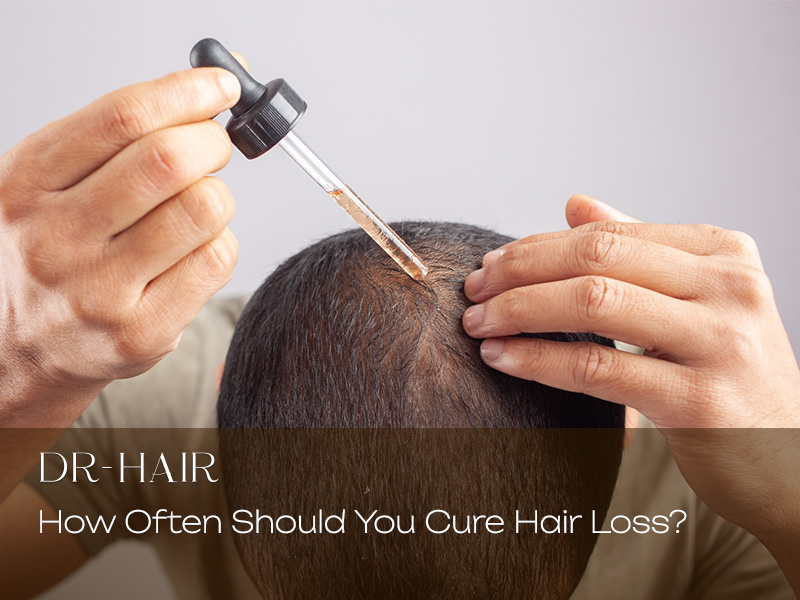Cure Hair Loss
Hair loss is a deeply personal and sometimes emotional journey. Whether you’re noticing more strands in the shower or a thinning crown in photos, it’s natural to wonder: How often should I be treating this? The truth is, there isn’t a one-size-fits-all schedule. Frequency of treatment depends on the cause of your hair loss, the type of treatment you’re using, and how your body responds.
In this post, we’ll explore how often you should treat hair loss—based on expert insight—and what consistency really looks like when you’re trying to cure hair loss or at least significantly slow it down.
Understanding Hair Loss: Causes First, Cure Second
Before you begin any treatment, it’s essential to understand why you’re experiencing hair loss. Common causes include:
-
Genetic (Androgenetic Alopecia): The most common type, often hereditary.
-
Hormonal Changes: Like those during pregnancy, menopause, or thyroid issues.
-
Stress and Lifestyle: High stress, poor diet, and lack of sleep can contribute.
-
Medical Conditions: Autoimmune diseases (like alopecia areata) or side effects of medications.
-
Hair Care Habits: Over-styling, tight hairstyles, or chemical damage.
Once the cause is diagnosed—ideally with the help of a dermatologist or trichologist—treatment can begin, and frequency becomes clearer.
How Often Should You Treat Hair Loss?
Let’s break down frequency by treatment type.
1. Topical Treatments (Minoxidil/Rogaine)
-
Frequency: Daily (Once or twice)
-
How It Works: Stimulates hair follicles and improves blood flow.
-
Best For: Early stages of thinning and androgenetic alopecia.
-
Timeline to Expect Results: 3-6 months minimum
You’ll need to apply minoxidil consistently—usually twice a day for men and once for women. Skipping applications can lead to regression, so consistency is key.
2. Oral Medications (Finasteride or Dutasteride)
-
Frequency: Daily
-
How It Works: Blocks DHT, the hormone responsible for shrinking hair follicles.
-
Best For: Men with male pattern baldness.
-
Timeline to Expect Results: 3-6 months
Once prescribed, oral medications are taken once per day. Long-term use is often required, and stopping can reverse progress.
3. PRP Therapy (Platelet-Rich Plasma)
-
Frequency: Every 4-6 weeks (for first 3-4 sessions), then maintenance every 3-6 months
-
How It Works: Uses your blood’s platelets to stimulate growth.
-
Best For: Early to moderate hair thinning, postpartum hair loss, or boosting other treatments.
-
Timeline to Expect Results: 3-4 months after initial sessions
This is one of the more promising treatments if you’re looking to cure hair loss naturally, though results vary and multiple sessions are necessary.
4. Hair Transplants
-
Frequency: One-time procedure (with potential for follow-up)
-
How It Works: Hair follicles are moved from one area to another.
-
Best For: Advanced hair loss with minimal regrowth potential
-
Timeline to Expect Results: 6-12 months
Hair transplants are a more permanent solution. However, post-op maintenance with other therapies (like minoxidil or PRP) is often recommended to protect existing hair.
5. Laser Therapy (LLLT)
-
Frequency: 3-4 times a week
-
How It Works: Low-level lasers stimulate follicle activity.
-
Best For: Early-stage hair loss, postpartum shedding
-
Timeline to Expect Results: 4-6 months
Consistency is essential. Many patients combine LLLT with topical or oral treatments for maximum benefit.
Combining Treatments: A Smart Strategy
Many professionals recommend combination therapy—using two or more treatments together. For example:
-
Minoxidil + Finasteride
-
PRP + Topicals
-
LLLT + Supplements
This multi-pronged approach improves the chance of success and can even help cure hair loss over time by addressing different root causes. However, the frequency of each must still be respected.
How Long Should You Keep Treating Hair Loss?
Hair loss treatment is often a long-term commitment. Even if you see results, stopping your routine too soon can undo progress. Most experts advise continuing treatment indefinitely if you want to maintain results—especially with conditions like genetic baldness.
Think of it like skincare: once you stop moisturizing or using sunscreen, the issues often return. Your hair is the same—it needs ongoing support.
Signs It’s Time to Adjust Frequency
You might need to change your treatment frequency if:
-
You’re experiencing scalp irritation or side effects.
-
Your hair loss has stabilized or significantly improved.
-
You’ve started a new treatment or supplement.
-
Your doctor suggests tapering down or alternating therapies.
Always consult with your provider before making changes, especially with medications.
FAQs About How to Cure Hair Loss
1. Can you really cure hair loss permanently?
It depends on the cause. Genetic hair loss (like male or female pattern baldness) can be managed and slowed significantly, but “curing” it typically involves surgical intervention like a hair transplant. However, autoimmune or stress-induced hair loss can sometimes be reversed completely.
2. How soon should I see results from treatments?
Most treatments take 3 to 6 months to show visible results. Some people may see shedding before regrowth, which is normal as new hair pushes old strands out.
3. What happens if I stop using my treatment?
If you stop, hair loss often returns—sometimes worse. This is especially true with minoxidil or finasteride, where discontinuation usually causes you to lose the regrown hair within months.
4. Are natural remedies effective for curing hair loss?
Some natural approaches—like rosemary oil, pumpkin seed oil, or saw palmetto—show promise but usually offer mild results. They’re best used as supportive treatments, not standalone cures.
5. How do I know if a treatment is working?
Track progress with photos every 4 weeks, note reduced shedding, and watch for regrowth around the temples or crown. Patience and consistency are key.
Conclusion
Trying to cure hair loss isn’t a one-time fix—it’s an ongoing process that requires a tailored plan and commitment. Whether you’re using daily topicals or undergoing monthly PRP sessions, staying consistent and realistic about your timeline is essential.
Consulting with a hair restoration professional can help you create the right frequency and combination for your needs. And remember: the earlier you start, the better the outcome.
